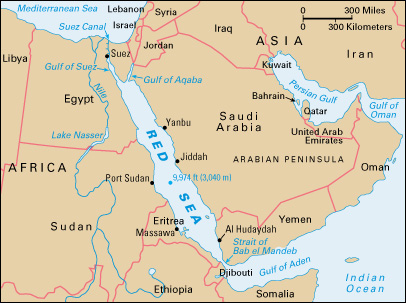Red Sea is a long, narrow arm of the Indian Ocean that separates the Arabian Peninsula from northeastern Africa. The sea ranks as one of the world’s busiest waterways. Much of the trade between Europe and Asia passes through the Red Sea, which is connected with the Mediterranean Sea by the Suez Canal. Scholars are uncertain about the origin of the sea’s name. One widely held theory is that the Red Sea is so named because a type of algae forms a reddish-brown scum on its surface during the summer.

The Red Sea covers about 176,000 square miles (456,000 square kilometers), an area larger than the state of California. The sea is about 1,400 miles (2,200 kilometers) long and about 220 miles (350 kilometers) wide at its widest point. Its average depth is 1,765 feet (538 meters). Its deepest point is 9,974 feet (3,040 meters).
At its northern end, the Red Sea branches into the Gulf of Suez on the west and the Gulf of Aqaba on the east. The Sinai Peninsula lies between the two gulfs. The Gulf of Suez, a major offshore oil-producing area, leads into the Suez Canal. The Gulf of Aqaba leads to the Israeli port of Elat and the Jordanian port of Aqaba. At the southern end of the Red Sea, a narrow waterway called the Strait of Bab el Mandeb flows into the Gulf of Aden, which, in turn, leads into the Indian Ocean.
The Red Sea lies in the Great Rift Valley system, a series of valleys that cut through much of eastern Africa and part of southwestern Asia. High cliffs tower above both banks of the sea. In most places, narrow coastal plains lie between the cliffs and the sea. The Red Sea has large numbers of coral reefs. The reefs, together with irregular currents and strong winds, make navigation in the Red Sea difficult for small vessels.
In summer, the water temperature at the surface of the Red Sea averages 85 °F (29 °C). The waters are among the saltiest in the world. Extreme heat in the region produces a rapid rate of evaporation, resulting in the high salt concentration. Some salt is collected in evaporation pans for local use. Many varieties of fish live in the Red Sea. But the number of fish of each variety is too small to make commercial fishing profitable.
The Red Sea was probably formed millions of years ago when the Arabian Peninsula and the African continent drifted apart. One of the most famous stories in the Bible describes the parting of the waters of the Red Sea, which enabled the Israelites to escape from Egypt (Exodus 14). However, because the Hebrew text actually says “sea of reeds,” most modern scholars believe the body of water was actually the marshy lands east of the Nile Delta, well to the north of the Red Sea.
The Red Sea has served as an important trade route since ancient times. Before the opening of the Suez Canal in 1869, goods were transported overland by camel or donkey between the Mediterranean and Red seas.
